Abstract
After tularemia vaccinations, most individuals respond with cell-mediated and humoral immunity as disclosed by the lymphocyte stimulation test and enzyme-linked immunosorbent assay (ELISA), respectively. There is, however, no correlation between the magnitudes of the two responses, and some individuals show one of the responses only. We now report that the two responses are directed towards different antigenic determinants of the bacterium. Ether-water extraction of the live vaccine strain of Francisella tularensis gave a high yield of material reacting in ELISA as well as in the lymphocyte stimulation test. However, the specificity of the extract was low insofar as it reacted not only with lymphocytes and antibodies of tularemia-vaccinated individuals but also to a fairly high extent with those of nonvaccinated individuals. By using the extract as a starting material, a preparatory procedure was developed, resulting in antigen of high specificity in the two tests. The antigen prepared was a high-molecular-weight, carbohydrate-protein complex. Proteinase K treatment of the antigen abolished the lymphocyte-stimulating activity but did not decrease ELISA activity at all. Periodate treatment, on the other hand, greatly reduced ELISA activity but did not decrease the lymphocyte-stimulating activity. Thus, determinants of F. tularensis responsible for immunospecific lymphocyte stimulation seem to reside in protein, whereas ELISA activity seems to be due mostly to carbohydrate determinants.
Full text
PDF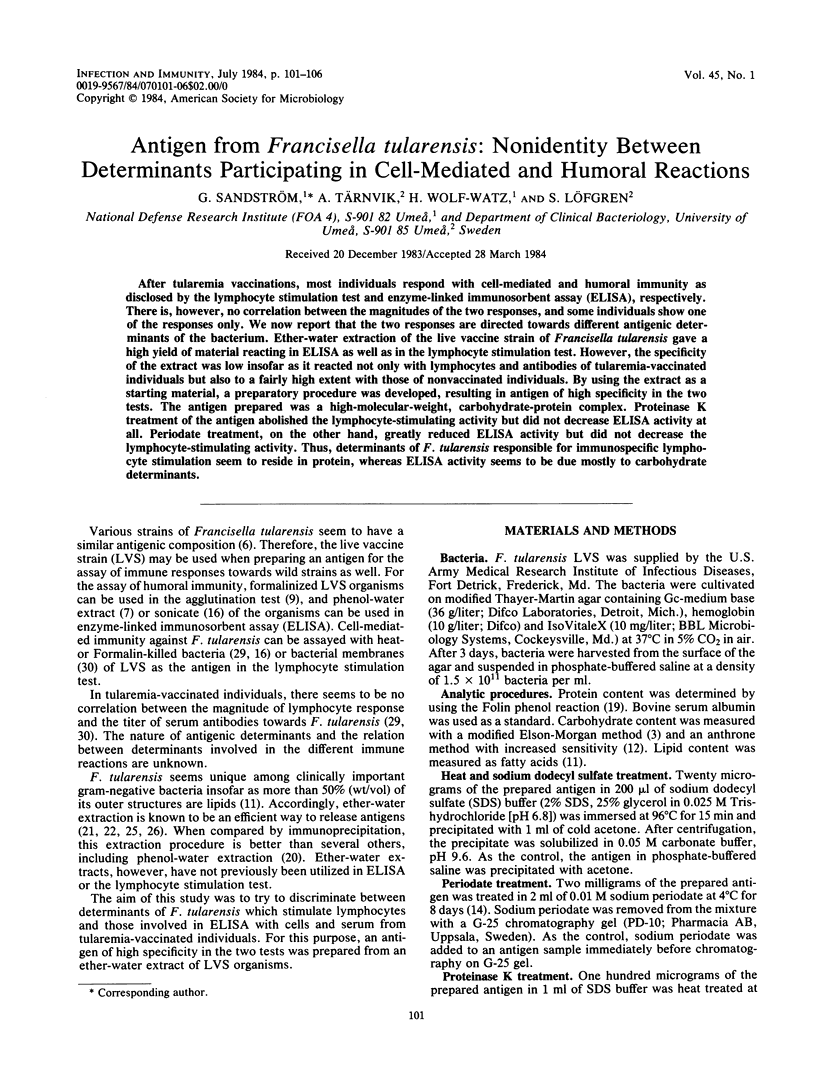
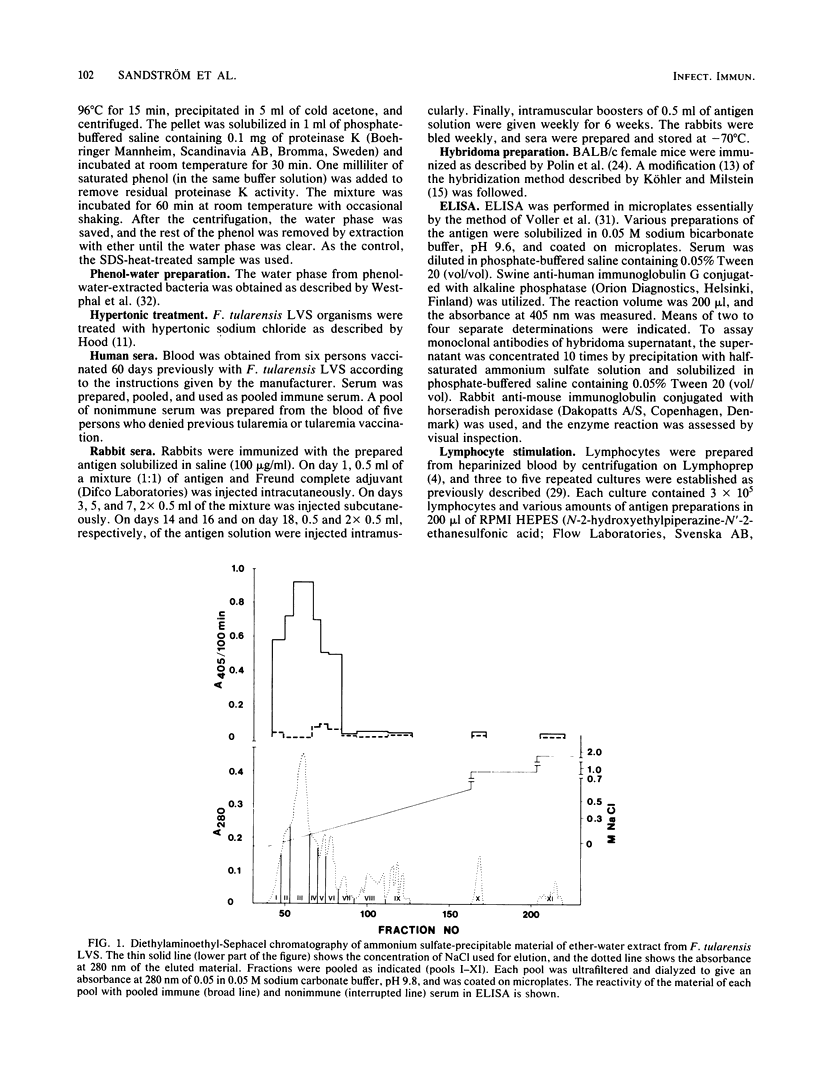
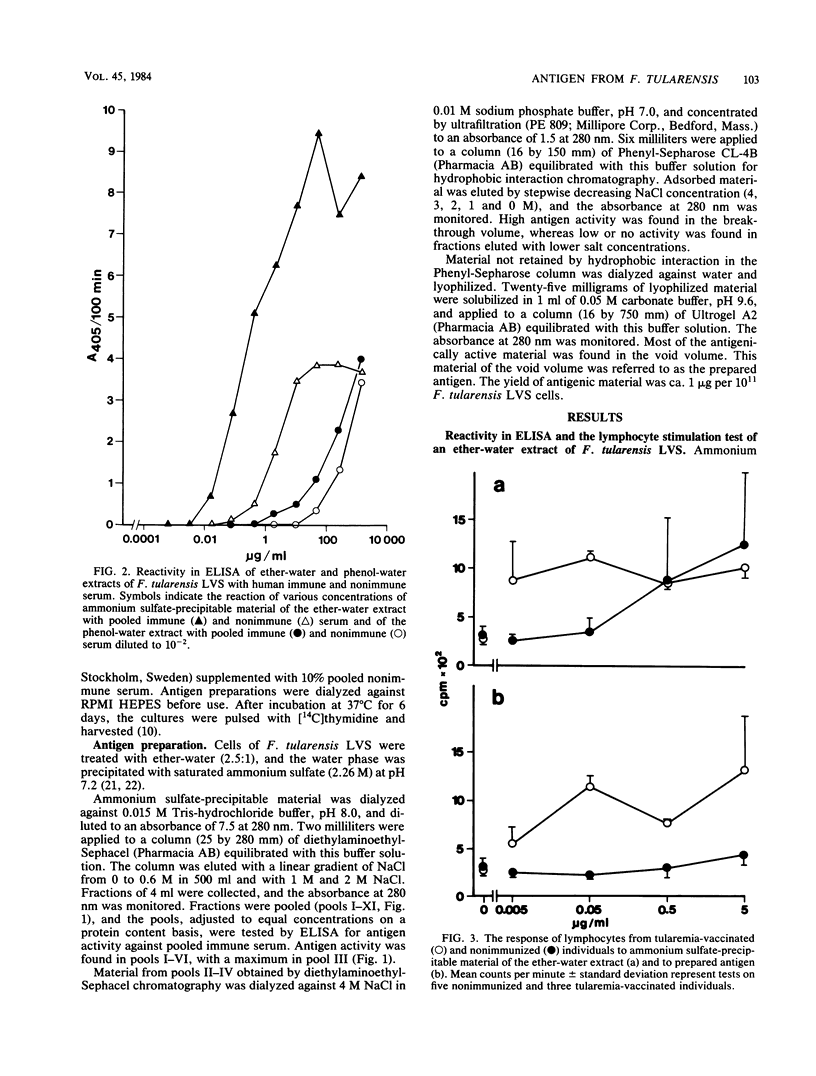
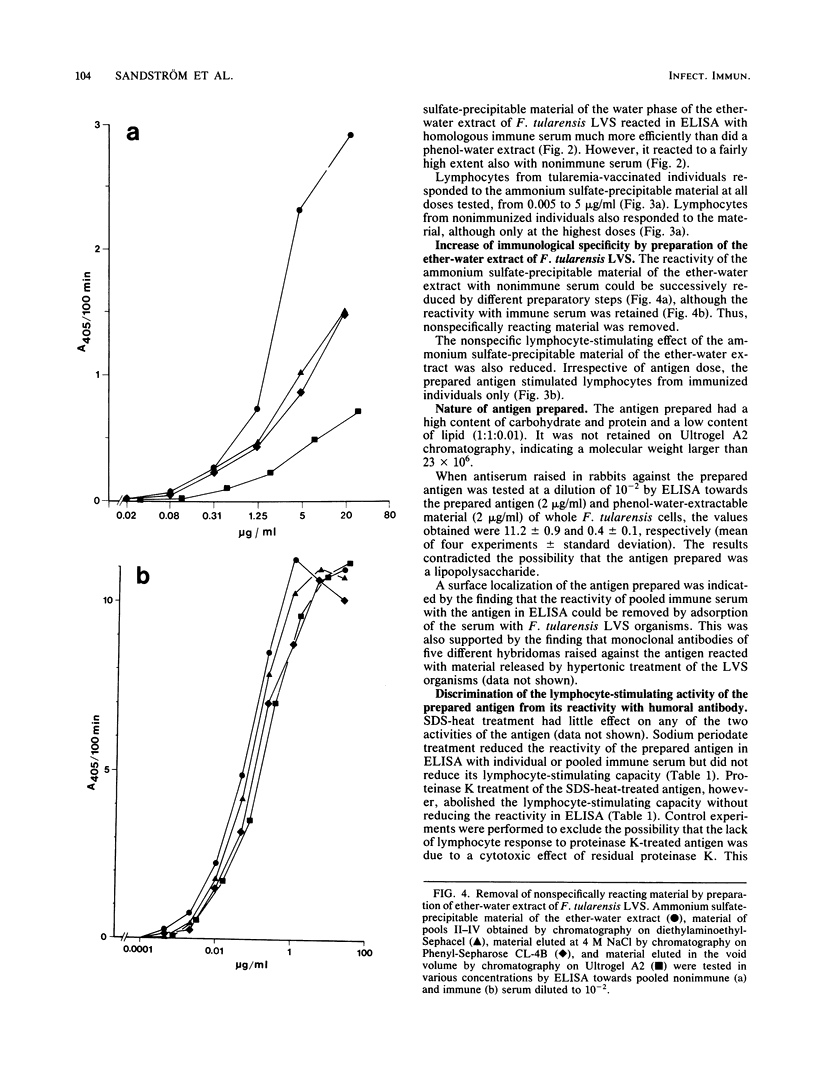
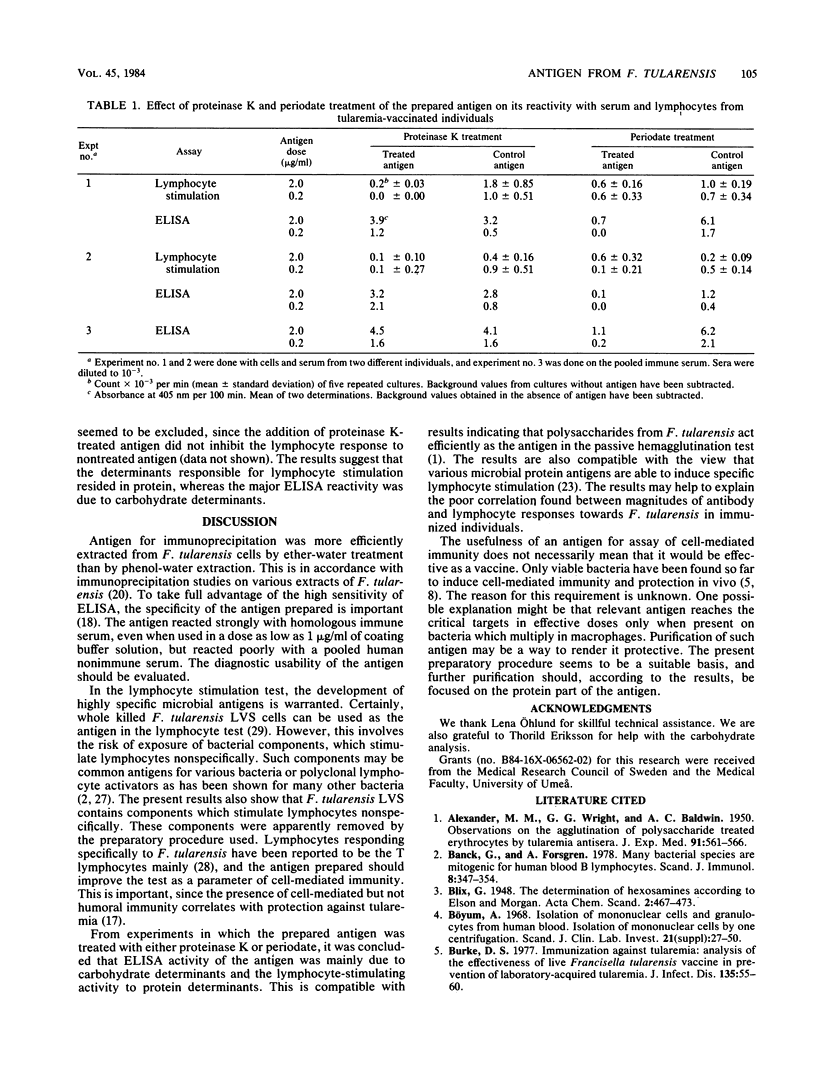
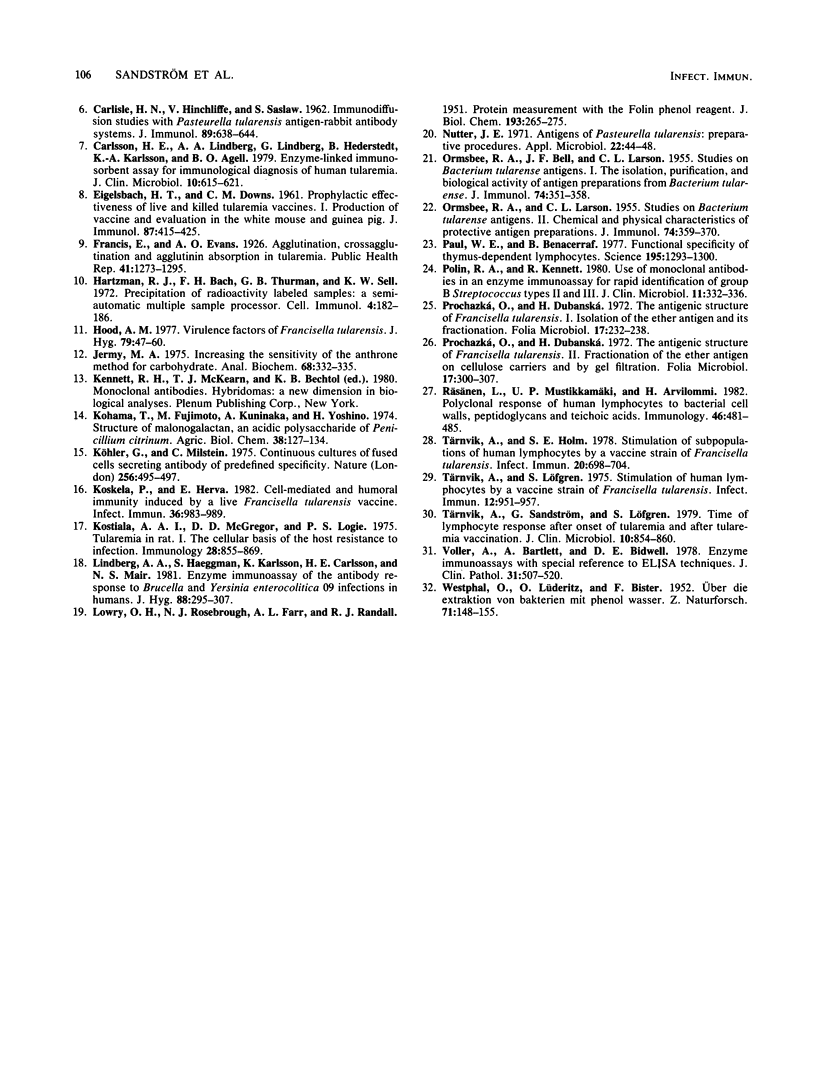
Selected References
These references are in PubMed. This may not be the complete list of references from this article.
- ALEXANDER M. M., WRIGHT G. G., BALDWIN A. C. Observations on the agglutination of polysaccharide-treated erythrocytes by tularemia antisera. J Exp Med. 1950 Jun 1;91(6):561–566. doi: 10.1084/jem.91.6.561. [DOI] [PMC free article] [PubMed] [Google Scholar]
- Banck G., Forsgren A. Many bacterial species are mitogenic for human blood B lymphocytes. Scand J Immunol. 1978;8(4):347–354. doi: 10.1111/j.1365-3083.1978.tb00528.x. [DOI] [PubMed] [Google Scholar]
- Burke D. S. Immunization against tularemia: analysis of the effectiveness of live Francisella tularensis vaccine in prevention of laboratory-acquired tularemia. J Infect Dis. 1977 Jan;135(1):55–60. doi: 10.1093/infdis/135.1.55. [DOI] [PubMed] [Google Scholar]
- CARLISLE H. N., HINCHLIFFE V., SASLAW S. Immunodiffusion studies with Pasteurella tularensis antigen-rabbit antibody systems. J Immunol. 1962 Nov;89:638–644. [PubMed] [Google Scholar]
- Carlsson H. E., Lindberg A. A., Lindberg G., Hederstedt B., Karlsson K. A., Agell B. O. Enzyme-linked immunosorbent assay for immunological diagnosis of human tularemia. J Clin Microbiol. 1979 Nov;10(5):615–621. doi: 10.1128/jcm.10.5.615-621.1979. [DOI] [PMC free article] [PubMed] [Google Scholar]
- EIGELSBACH H. T., DOWNS C. M. Prophylactic effectiveness of live and killed tularemia vaccines. I. Production of vaccine and evaluation in the white mouse and guinea pig. J Immunol. 1961 Oct;87:415–425. [PubMed] [Google Scholar]
- Hartzman R. J., Bach M. L., Bach F. H., Thurman G. B., Sell K. W. Precipitation of radioactively labeled samples: a semi-automatic multiple-sample processor. Cell Immunol. 1972 Jun;4(2):182–186. doi: 10.1016/0008-8749(72)90018-4. [DOI] [PubMed] [Google Scholar]
- Hood A. M. Virulence factors of Francisella tularensis. J Hyg (Lond) 1977 Aug;79(1):47–60. doi: 10.1017/s0022172400052840. [DOI] [PMC free article] [PubMed] [Google Scholar]
- Jermyn M. A. Increasing the sensitivity of the anthrone method for carbohydrate. Anal Biochem. 1975 Sep;68(1):332–335. doi: 10.1016/0003-2697(75)90713-7. [DOI] [PubMed] [Google Scholar]
- Koskela P., Herva E. Cell-mediated and humoral immunity induced by a live Francisella tularensis vaccine. Infect Immun. 1982 Jun;36(3):983–989. doi: 10.1128/iai.36.3.983-989.1982. [DOI] [PMC free article] [PubMed] [Google Scholar]
- Kostiala A. A., McGregor D. D., Logie P. S. Tularaemia in the rat. I. The cellular basis on host resistance to infection. Immunology. 1975 May;28(5):855–869. [PMC free article] [PubMed] [Google Scholar]
- Köhler G., Milstein C. Continuous cultures of fused cells secreting antibody of predefined specificity. Nature. 1975 Aug 7;256(5517):495–497. doi: 10.1038/256495a0. [DOI] [PubMed] [Google Scholar]
- LOWRY O. H., ROSEBROUGH N. J., FARR A. L., RANDALL R. J. Protein measurement with the Folin phenol reagent. J Biol Chem. 1951 Nov;193(1):265–275. [PubMed] [Google Scholar]
- Lindberg A. A., Haeggman S., Karlson K., Carlsson H. E., Mair N. S. Enzyme immunoassay of the antibody response to Brucella and Yersinia enterocolitica 09 infections in humans. J Hyg (Lond) 1982 Apr;88(2):295–307. doi: 10.1017/s0022172400070157. [DOI] [PMC free article] [PubMed] [Google Scholar]
- Nutter J. E. Antigens of Pasteurella tularensis: preparative procedures. Appl Microbiol. 1971 Jul;22(1):44–48. doi: 10.1128/am.22.1.44-48.1971. [DOI] [PMC free article] [PubMed] [Google Scholar]
- ORMSBEE R. A., BELL J. F., LARSON C. L. Studies on Bacterium tularense antigens. I. The isolation, purification, and biologic activity of antigen preparations from Bacterium tularense. J Immunol. 1955 May;74(5):351–358. [PubMed] [Google Scholar]
- ORMSBEE R. A., LARSON C. L. Studies on Bacterium tularense antigens. II. Chemical and physical characteristics of protective antigen preparations. J Immunol. 1955 May;74(5):359–370. [PubMed] [Google Scholar]
- Paul W. E., Benacerraf B. Functional specificity of thymus- dependent lymphocytes. Science. 1977 Mar 25;195(4284):1293–1300. doi: 10.1126/science.320663. [DOI] [PubMed] [Google Scholar]
- Polin R. A., Kennett R. Use of monoclonal antibodies in an enzyme immunoassay for rapid identification of group B Streptococcus types II and III. J Clin Microbiol. 1980 Apr;11(4):332–336. doi: 10.1128/jcm.11.4.332-336.1980. [DOI] [PMC free article] [PubMed] [Google Scholar]
- Procházka O., Dubanská H. The antigenic structure of Francisella tularensis. I. Isolation of the ether antigen and its fractionation. Folia Microbiol (Praha) 1972;17(3):232–238. doi: 10.1007/BF02875819. [DOI] [PubMed] [Google Scholar]
- Procházka O., Dubanská H. The antigenic structure of Francisella tularensis. II. Fractionation of the ether antigen on cellulose carriers and by gel filtration. Folia Microbiol (Praha) 1972;17(4):300–307. doi: 10.1007/BF02880205. [DOI] [PubMed] [Google Scholar]
- Public Health Weekly Reports for JUNE 25, 1926. Public Health Rep. 1926 Jun 25;41(26):1273–1339. [PMC free article] [PubMed] [Google Scholar]
- Räsänen L., Mustikkamäki U. P., Arvilommi H. Polyclonal response of human lymphocytes to bacterial cell walls, peptidoglycans and teichoic acids. Immunology. 1982 Jul;46(3):481–486. [PMC free article] [PubMed] [Google Scholar]
- Tärnvik A., Holm S. E. Stimulation of subpopulations of human lymphocytes by a vaccine strain of Francisella tularensis. Infect Immun. 1978 Jun;20(3):698–704. doi: 10.1128/iai.20.3.698-704.1978. [DOI] [PMC free article] [PubMed] [Google Scholar]
- Tärnvik A., Löfgren S. Stimulation of human lymphocytes by a vaccine strain of Francisella tularensis. Infect Immun. 1975 Nov;12(5):951–957. doi: 10.1128/iai.12.5.951-957.1975. [DOI] [PMC free article] [PubMed] [Google Scholar]
- Tärnvik A., Sandström G., Löfgren S. Time of lymphocyte response after onset of tularemia and after tularemia vaccination. J Clin Microbiol. 1979 Dec;10(6):854–860. doi: 10.1128/jcm.10.6.854-860.1979. [DOI] [PMC free article] [PubMed] [Google Scholar]
- Voller A., Bartlett A., Bidwell D. E. Enzyme immunoassays with special reference to ELISA techniques. J Clin Pathol. 1978 Jun;31(6):507–520. doi: 10.1136/jcp.31.6.507. [DOI] [PMC free article] [PubMed] [Google Scholar]


